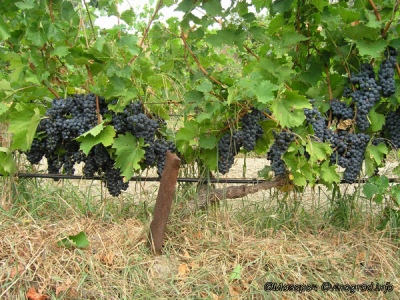
- Authors: VNIIViV "Magarach"
- Appointment: technical
- Berry color: black
- Taste: harmonious, nutmeg
- Ripening period: average
- Frost resistance, ° C: -26
- Yield: 140 kg / ha
- Flower type: bisexual
- Appeared when crossing: Muscat VIRa x Magarach No. 124-66-26
- Year of approval: 2007
There is not much difference between growing grapes in your own yard or in a large vineyard. The only difference is the space and the number of bushes.
As a rule, technical varieties are used for wine, among which Alminsky is not the last.
Breeding history
This grape was bred in VNIIViV "Magarach". Raw material steel:
Muscat VIR;
Magarach No. 124-66-26.
Alminsky was approved for use in 2007.
Description
Since the described variety is used exclusively for the production of wine, it is classified as technical. If we talk about the vigor of shoot growth, then it is average, so intensive pruning is not required.
Ripening period
The ripening period of this grape variety is average.
Bunches
As for the size of the bunches, for technical grapes they are quite large and can reach in mass from 300 to 400 grams.
Berries
By color, the fruits of the Alma are black. They contain about 300 g / dm³. The fruits are round, small.
Taste
Tasters talk about the taste of the described variety simply, it is nutmeg and harmonious.
Yield
The yield of adult vines is 140 kg / ha.


Growing features
Mulching is a must if grapes are grown on the ground. When the grower adds mulch, it prevents too much water from evaporating from the soil and protects the roots from damage.
The best mulch for grapes is pine bark, compost, shredded leaves, or pebbles. Pebbles look their best. It is worth adding a new layer of mulch every year as it tends to diminish with watering.
Landing
Dig a hole, which should be twice the size of the root ball. After laying the seedling, it is covered with the same soil that was taken out when digging the planting hole.
After planting, a thin layer of compost is spread over the soil to retain moisture and provide nutrients. Do not fertilize a freshly planted vine until it is actively growing. It usually takes about a few months.
The ideal time to plant grapes depends on where the grower lives. If this is an area of mild climate, then the best time for planting is spring or early summer. Best, because the plant has time to grow without frost that stuns growth.
Those who live in the tropics can plant seedlings in winter.

Pollination
Flowers of both sexes form on the vine - the type of flower is bisexual.
Pruning
For several months after planting until the end of the first growing season, there is no need to prune the plants. They need to grow freely and develop a strong root system.
But it is worth removing shoots that are more than two years old and those that do not bear more fruit.
The best time to prune grapes is from late winter to early spring, leaving only two buds.
The most serious pruning occurs at the end of winter, when the plant begins to shed its leaves. In the summer, if they do pruning, then only slightly.

Watering
The vines need to be watered regularly and deeply, but the soil should only be slightly damp. It is very important not to overmoisten the plants, because damp soil is the first cause of mold.


Top dressing
Like any plant, grapes need fertilization. In the first year, general-purpose mixes are added to the soil to aid growth.
Every year the vine is periodically fed with aged manure or compost. Fertilizers with a low nitrogen content and a high content of potassium and phosphorus are also used. They are especially important in the spring when buds begin to appear. Phosphorus is also needed when fruits begin to appear on the bushes.
Frost resistance and the need for shelter
The level of frost resistance is at around –26 degrees. If it is supposed to plant grapes in a region where it is colder, then it is worth covering it for winter. The easiest option is to use branches of coniferous trees. The most expensive is special agrofibre.

Diseases and pests
During the growing season, the vine must undergo preventive treatment twice. The first is necessary before the flowers appear on the shoots, the second after flowering.
If we talk about resistance to diseases characteristic of this garden culture, then Alminsky is resistant to phylloxera, gray rot, mildew and powdery mildew.

If a grape is exposed to any disease or insect, this always affects its appearance.
Storage
The grapes are not stored, for this reason they are sent for processing immediately after harvesting.











































































